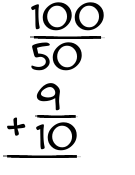What is 100/50 + 9/10?

|
Let's add
|
||||||||||||||||||
Step 1Our denominators (bottom numbers) don't match, so we can't add yet. 50 goes into 10 evenly, so we only need to multiply one term to get a common denominator. Multiply 9 by 5, and get 45, then we multiply 10 by 5 and get 50. This gives us a new problem that looks like so:
|
||||||||||||||||||
Step 2Since our denominators match, we can add the numerators. 100 + 45 = 145 That gives us an answer of
|
||||||||||||||||||
Step 3Can this fraction be reduced? First, we attempt to divide it by 2... Nope. Try the next prime number, 3... Nope. Try the next prime number, 5... Are both the numerator and the denominator evenly divisible by 5? Yes! So we reduce it:
Now, try the same number again. Nope. Try the next prime number, 7... Nope. Try the next prime number, 11... No good. 11 is larger than 10. So we're done reducing. Congratulations! Here's your final answer to 100/50 + 9/10
|